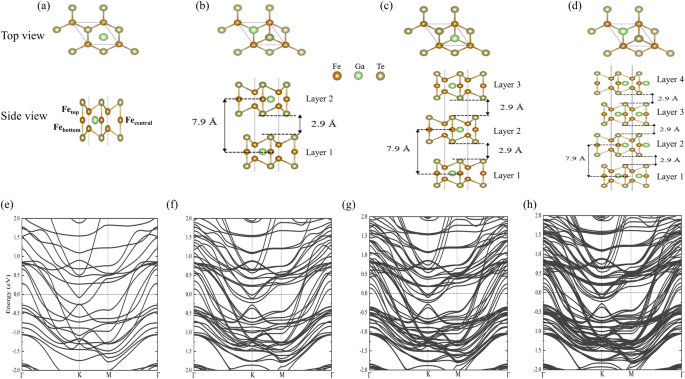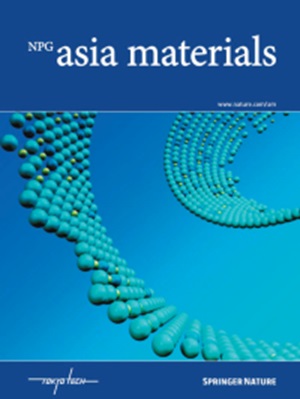原子级薄二维 Fe3GaTe2 中的大反常横向输运特性
IF 8.3
2区 材料科学
Q1 MATERIALS SCIENCE, MULTIDISCIPLINARY
引用次数: 0
摘要
反常横向电导率,如反常霍尔电导率(AHC)、反常奈氏电导率(ANC)和反常热霍尔电导率(ATHC),在新兴的自旋电子学领域发挥着至关重要的作用。受最近制备的二维(2D)铁磁薄膜 Fe3GaTe2 的启发,我们研究了二维 Fe3GaTe2 系统(从一层到四层)随厚度变化的反常横向电导率。原子超薄二维 Fe3GaTe2 系统显示出高于室温的铁磁性,具有很大的垂直磁各向异性能。此外,我们还在四层厚度内获得了-485 S/cm的大AHC,而在掺杂少量电子后,AHC进一步增强到-550 S/cm。这个 AHC 比在更厚的二维 Fe3GaTe2(178 nm)中测得的 AHC 大七倍。在四层结构中,ANC 也达到了 0.55 A/K.m。此外,四层系统还显示出较大的 ATHC(-0.105 ~ -0.135 W/K.m)。这一 ATHC 与在 Weyl 半金属 Co3Sn2S2 中发现的大 ATHC 相当。根据我们的研究结果,原子超薄二维 Fe3GaTe2 系统显示出卓越的反常横向电导率,可作为未来自旋电子学和自旋热电子器件应用的潜在平台。本文章由计算机程序翻译,如有差异,请以英文原文为准。


Large anomalous transverse transport properties in atomically thin 2D Fe3GaTe2
Anomalous transverse conductivities, such as anomalous Hall conductivity (AHC), anomalous Nernst conductivity (ANC), and anomalous thermal Hall conductivity (ATHC), play a crucial role in the emerging field of spintronics. Motivated by the recent fabrication of two-dimensional (2D) ferromagnetic thin film Fe3GaTe2, we investigate the thickness-dependent anomalous transverse conductivities of the 2D Fe3GaTe2 system (from one to four layers). The atomically ultrathin 2D Fe3GaTe2 system shows above-room-temperature ferromagnetism with a large perpendicular magnetic anisotropy energy. Furthermore, we obtain a large AHC of −485 S/cm in the four-layer thickness, and this is further enhanced to −550 S/cm with small electron doping. This AHC is seven times larger than the measured AHC in thicker 2D Fe3GaTe2 (178 nm). The ANC also reaches 0.55 A/K.m in the four-layer structure. Along with these, the four-layer system exhibits a large ATHC (−0.105 ~ −0.135 W/K.m). This ATHC is comparable to the large ATHC found in Weyl semimetal Co3Sn2S2. Based on our results, the atomically ultrathin 2D Fe3GaTe2 system shows outstanding anomalous transverse conductivities and can be utilized as a potential platform for future spintronics and spin caloritronic device applications. Two-dimensional materials have become popular in science due to their unique characteristics and potential for new technologies. In this study, researchers examined a specific 2D material, Fe3GaTe2, which has shown potential due to its strong magnetism at high temperatures, making it suitable for spintronics devices that operate at room temperature or above. The team performed calculations to investigate how the thickness of Fe3GaTe2 layers impacts their magnetic and anomalous transport properties. In conclusion, the study showed that adding more layers to the Fe3GaTe2 single layer improves its anomalous transverse conductivities, which could lead to better performance in future spintronic devices. The findings suggest that ultra-thin layers of this material could be very useful in the field of spintronics, potentially leading to more efficient and powerful technology. This summary was initially drafted using artificial intelligence, then revised and fact-checked by the author. We investigate the anomalous transverse conductivities of a two-dimensional (2D) magnetic Fe3GaTe2 system (monolayer to four-layer thickness). A giant anomalous thermal Hall conductivity (ATHC) of -0.14 W/K.m is obtained in the four-layer structure, and this value is comparable to the typical ATHC found in bulk materials which is rare to find in low-dimensional systems. Our findings suggest that the ultra-thin 2D Fe3GaTe2 system could be a promising platform for future spintronics and spin caloritronics device applications.
求助全文
通过发布文献求助,成功后即可免费获取论文全文。
去求助
来源期刊

Npg Asia Materials
MATERIALS SCIENCE, MULTIDISCIPLINARY-
CiteScore
15.40
自引率
1.00%
发文量
87
审稿时长
2 months
期刊介绍:
NPG Asia Materials is an open access, international journal that publishes peer-reviewed review and primary research articles in the field of materials sciences. The journal has a global outlook and reach, with a base in the Asia-Pacific region to reflect the significant and growing output of materials research from this area. The target audience for NPG Asia Materials is scientists and researchers involved in materials research, covering a wide range of disciplines including physical and chemical sciences, biotechnology, and nanotechnology. The journal particularly welcomes high-quality articles from rapidly advancing areas that bridge the gap between materials science and engineering, as well as the classical disciplines of physics, chemistry, and biology. NPG Asia Materials is abstracted/indexed in Journal Citation Reports/Science Edition Web of Knowledge, Google Scholar, Chemical Abstract Services, Scopus, Ulrichsweb (ProQuest), and Scirus.
 求助内容:
求助内容: 应助结果提醒方式:
应助结果提醒方式:


